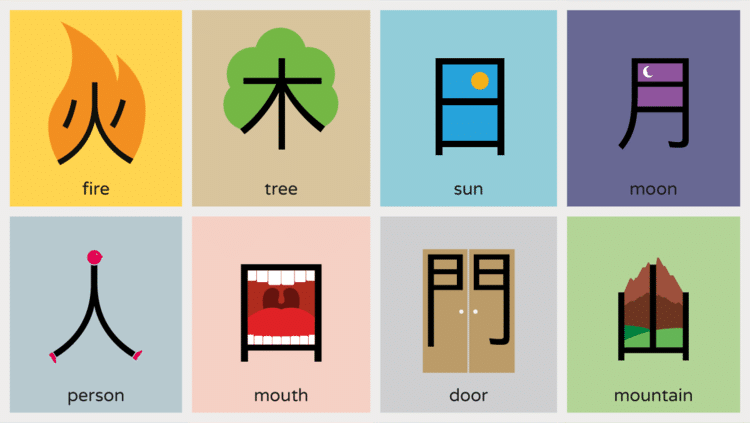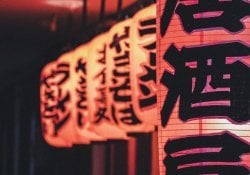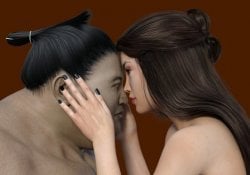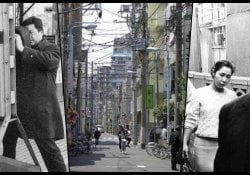In this article, we are going to see a complete list of N5 ideograms or Kanji used in the JLPT, Japanese Language Proficiency Test. A total of 167 Kanji organized by the number of strokes and with their kun and on readings.
We didn't put the romanized readings, because it doesn't make much sense to do that. If you are already studying N5, your minimum obligation is to know how to read hiragana and katakana. Luckily, we'll also leave a simplified list with romaji.

Índice de Conteúdo
Does Kanji N5 have meanings?
First of all, we don't want you to get caught up in the idea that Japanese characters have meanings of their own. Most of the time they just convey a certain idea or concept according to the words in which they compose.
An ideogram alone will not convey the idea of absolutely anything, the meanings that you will see in this article are just some of the words and similar in which they compose. Get out of your head that ideograms have meanings!
For example, the character of [人] person is used to compose many words related to humanity, population, man, human and anything related. Clearly when we see this ideogram we remember a person, and it literally alone means that, but most ideograms don't have a meaning when they are alone.
For example, the character [食] used to write verbs like eat [食べる] is also present in many food-related words, but alone it means nothing. It just passes the idea and concept of food.
I believe that N5 is one of the few levels in the list of ideograms where most of them form a single word. In this case, the main ones are numbers, colors, positions and others. Still, it conveys more ideas than a single meaning.
List ideograms and Kanji N5
The translation is done from English to Japanese and has several meanings in a single ideogram. This doesn't necessarily mean that this kanji means that, but that perhaps a compound word with that kanji has that meaning.
Japanese ideograms usually convey the idea of something, it may not make sense to imagine this idea in isolation. The translations may not be 100% accurate, if you want to dig further we recommend the jisho.
Responsive Table: Scroll the table sideways with your finger >>
| traits | Kanji N5 | Meaning | Kun Yomi | On Yomi |
| 1 | 一 | one, a radical (no.1) | ひと-、 ひと.つイチ、 イツ | |
| 2 | 人 | person | ひと、 -り、 -と | ジン、 ニン |
| 2 | 十 | ten | とお、 と | ジュウ、 ジッ、ジュッ |
| 2 | 二 | two, two radicals (#7) | ふた、 ふた.つ、 ふたたび | ニ、 ジ |
| 2 | 九 | nine | ここの、 ここの.つ | キュウ、 ク |
| 2 | 入 | enter, insert | い.る、 -い.る、 -い.り、 い.れる、 -い.れ、 はい.る | ニュウ、 ジュ |
| 2 | 八 | eight, eight radicals (nº 12) | や、 や.つ、 やっ.つ、 よう | ハチ |
| 2 | 七 | Seven | なな、 なな.つ、 なの | シチ |
| 3 | 大 | big big | おお-、 おお.きい、 -おお.いに | ダイ、 タイ |
| 3 | 三 | three | み、 み.つ、 みっ.つ | サン、 ゾウ |
| 3 | 上 | above, above | うえ、 -うえ、 うわ-、 かみ、 あ.げる、 -あ.げる、 あ.がる、 -あ.がる、あ.がり、 -あ.がり、 のぼ.る、 のぼ.り、 のぼ.せる、のぼ.す、 たてまつ.る | ジョウ、 ショウ、シャン |
| 3 | 子 | child, sign of the rat, 23:00 – 01:00, first sign of the chinese zodiac | こ、 -こ、 ね | シ、 ス、 ツ |
| 3 | 下 | down, come down, give, down, inferior | した、 しも、 もと、 さ.げる、 さ.がる、 くだ.る、 くだ.り、 くだ.す、 -くだ.す、 くだ.さる、 お.ろす、 お.りる | カ、 ゲ |
| 3 | 小 | small small | ちい.さい、 こ-、お-、 さ- | ショウ |
| 3 | 山 | Mountain | やま | サン、 セン |
| 3 | 女 | woman woman | おんな、 め | ジョ、 ニョ、 ニョウ |
| 3 | 川 | radical of stream, river, river or three-stroke river (nº 47) | かわ | セン |
| 3 | 千 | thousand | ち | セン |
| 3 | 土 | soil, earth, terrain, turkey | つち | ド、 ト |
| 3 | 万 | ten thousand, 10,000 | よろず | マン、 バン |
| 4 | 日 | day, sun, japan, counter for days | ひ、 -び、 -か | ニチ、 ジツ |
| 4 | 中 | inside, middle, middle, middle, center | なか、 うち、 あた.る | チュウ |
| 4 | 月 | moon month | つき | ゲツ、 ガツ |
| 4 | 五 | five | いつ、 いつ.つ | ゴ |
| 4 | 円 | circle yen round | まる.い、 まる、 まど、 まど.か、 まろ.やか | エン |
| 4 | 六 | six | む、 む.つ、 むっ.つ、 むい | ロク、 リク |
| 4 | 今 | now | いま | コン、 キン |
| 4 | 水 | Water | みず、 みず- | スイ |
| 4 | 午 | noon, sign of the horse, 11am-1pm, seventh sign of the Chinese zodiac | うま | ゴ |
| 4 | 木 | tree wood | き、 こ- | ボク、 モク |
| 4 | 天 | sky, imperial | あまつ、 あめ、 あま- | テン |
| 4 | 火 | fire | ひ、 -び、 ほ- | カ |
| 4 | 友 | friend | とも | ユウ |
| 4 | 父 | dad | ちち | フ |
| 5 | 本 | book, present, main, origin, true, real, counter for long cylindrical things | もと | ホン |
| 5 | 出 | get out, get out, get out, get out, erase, stand out | で.る、 -で、 だ.す、 -だ.す、 い.でる、 い.だす | シュツ、 スイ |
| 5 | 生 | life, genuine, birth | い.きる、 い.かす、い.ける、 う.まれる、 うま.れる、う.まれ、 うまれ、う.む、 お.う、 は.える、 は.やす、き、 なま、 なま-、 な.る、 な.す、 む.す、 -う | セイ、 ショウ |
| 5 | 四 | four | よ、 よ.つ、 よっ.つ、 よん | シ |
| 5 | 外 | outside | そと、 ほか、 はず.す、 はず.れる、と- | ガイ、 ゲ |
| 5 | 北 | north | きた | ホク |
| 5 | 半 | half, half, odd number, semi-, part- | なか.ば | ハン |
| 5 | 白 | white | しろ、 しら-、 しろ.い | ハク、 ビャク |
| 5 | 右 | right | みぎ | ウ、 ユウ |
| 5 | 左 | left | ひだり | サ、 シャ |
| 5 | 母 | mother | はは、 も | ボ |
| 6 | 年 | year, counter for years | とし | ネン |
| 6 | 行 | going, journey, perform, conduct, act, line, line, bank | い.く、 ゆ.く、 -ゆ.き、 -ゆき、 -い.き、 -いき、 おこな.う、 おこ.なう | コウ、 ギョウ、 アン |
| 6 | 気 | spirit, mind, air, atmosphere, mood | いき | キ、 ケ |
| 6 | 百 | hundred | もも | ヒャク、 ビャク |
| 6 | 先 | before, ahead, previous, future, precedence | さき、 ま.ず | セン |
| 6 | 名 | name, noted, distinguished, reputation | な、 -な | メイ、 ミョウ |
| 6 | 西 | west spain | にし | セイ、 サイ、 ス |
| 6 | 休 | rest, day off, retire, sleep | やす.む、 やす.まる、 やす.める | キュウ |
| 6 | 毎 | each | ごと、 -ごと.に | マイ |
| 7 | 見 | see, hopes, chances, idea, opinion, look, visible | み.る、 み.える、み.せる | ケン |
| 7 | 来 | come, due, then cause, become | く.る、 きた.る、きた.す、 き.たす、き.たる、 き、 こ | ライ、 タイ |
| 7 | 男 | masculine | おとこ、 お | ダン、 ナン |
| 7 | 車 | car | くるま | シャ |
| 7 | 何 | what | なに、 なん、 なに-、 なん- | カ |
| 8 | 国 | country | くに | コク |
| 8 | 長 | long, leader, superior, senior | なが.い、 おさ | チョウ |
| 8 | 金 | gold | かね、 かな-、 -がね | キン、 コン、 ゴン |
| 8 | 学 | study, learning, science | まな.ぶ | ガク |
| 8 | 東 | east | ひがし | トウ |
| 8 | 雨 | rain | あめ、 あま-、 -さめ | ウ |
| 9 | 後 | back, after | のち、 うし.ろ、 うしろ、 あと、 おく.れる | ゴ、 コウ |
| 9 | 前 | in front, before | まえ、 -まえ | ゼン |
| 9 | 食 | eat food | く.う、 く.らう、た.べる、 は.む | ショク、 ジキ |
| 9 | 南 | south | みなみ | ナン、 ナ |
| 10 | 時 | time, time | とき、 -どき | ジ |
| 10 | 高 | high, high, expensive | たか.い、 たか、 -だか、 たか.まる、たか.める | コウ |
| 10 | 校 | exam, school, print, test, correction | コウ、 キョウ | |
| 10 | 書 | write | か.く、 -が.き、 -がき | ショ |
| 12 | 間 | range, space | あいだ、 ま、 あい | カン、 ケン |
| 13 | 話 | tale, conversation | はな.す、 はなし | ワ |
| 13 | 電 | electricity | デン | |
| 14 | 語 | word, speech, language | かた.る、 かた.らう | ゴ |
| 14 | 聞 | listen, ask, listen | き.く、 き.こえる | ブン、 モン |
| 14 | 読 | to read | よ.む、 -よ.み | ドク、 トク、 トウ |
Simplified and romanized N5 kanji list
Below is a list of the same ideograms as the simplified N5 with just a common meaning and a standard romanization as reading. You might want to start with this list, although we recommend the previous one.
This list below was just generated, if you want a more accurate and corrected N5 Kanji list try the previous one which is in hiragana and katakana.
Responsive Table: Scroll the table sideways with your finger >>
| N5 Kanji | Romaji | Meaning |
| 雨 | Ame | Rain |
| 安 | An | Cheap |
| 足 | Ashi | Foot |
| 後 | Ato | Back |
| 分 | Bun | Part |
| 父 | pee | Father |
| 長 | Chō | Boss |
| 中 | Chū | Medium |
| 大 | Dai | |
| 出 | De | Going out |
| 電 | Den | lightning |
| 土 | Of | Earth |
| 道 | Dō | Road |
| 駅 | Eki | Season |
| 円 | in | yen |
| 学 | Gaku | Learning |
| 月 | Gatsu | Month |
| 言 | Gen | Word |
| 五 | Go | Five |
| 語 | Go | Tongue |
| 行 | Gyō | Line |
| 八 | Hachi | Eight |
| 母 | Haha | Mother |
| 半 | Han | A half |
| 花 | Hana | Flower |
| 話 | Hanashi | Conversation |
| 左 | Left | Left |
| 東 | Higashi | East |
| 人 | hit | Man |
| 本 | Unfortunately, "hon" is untranslatable. | Book |
| 百 | Hyaku | 100 |
| 一 | Ichi | One |
| 今 | Ima | Now |
| 飲 | Em | Drink |
| 古 | Inishie | Antique |
| 入 | go | Entering |
| 時 | Ji | Hour |
| 上 | Jō | |
| 十 | Jū | Ten |
| 火 | Ka | third |
| 会 | Kai | Date |
| 買 | Kai | Shopping |
| 川 | Kawa | Rio |
| 気 | Ki | Spirit |
| 木 | Ki | Tree |
| 聞 | Kiki | Kiki |
| 金 | Kin | Money |
| 北 | Kita | Norte |
| 子 | Ko | Child |
| 校 | Kō | Escola |
| 高 | Kō | High |
| 口 | Kuchi | Mouth |
| 国 | Kuni | Country |
| 車 | Car | Car |
| 休 | Kyū | Kyū |
| 九 | Kyū | Nine |
| 間 | Bad | 1,818 m |
| 前 | Mom | The last |
| 毎 | May | Each |
| 万 | Homem | 10.000 |
| 目 | Eu | Eye |
| 名 | Mei | counter for people |
| 見 | I'm | To see |
| 右 | Right-handed | Certo |
| 耳 | Mimi | Ear |
| 南 | Minami | On |
| 店 | Mise | merchant's house |
| 水 | Water | Quarta-feira |
| 何 | Nan | what |
| 七 | Nana | Seven |
| 年 | baby | Year |
| 二 | Ni | Two |
| 日 | niche | Sunday |
| 西 | Nishi | Spain |
| 女 | Woman | Women |
| 男 | Otoko | Man |
| 来 | Rai | Next |
| 六 | rock | Six |
| 魚 | Sakana | Fish |
| 先 | Saki | Previous |
| 三 | San | Three |
| 生 | Sei | Pure |
| 千 | Yes | 1.000 |
| 社 | Sha | Company |
| 新 | Shin | Young |
| 白 | Shiro | White |
| 下 | Shita | lowness |
| 書 | Sho | Document |
| 小 | Shō | Small |
| 少 | Shō | Small |
| 食 | Shoku | Snack |
| 週 | Shū | Week |
| 空 | Sky | Empty |
| 外 | Soto | Outside of |
| 多 | Ta | Multi- |
| 立 | Tate | Only |
| 手 | Te | Hand |
| 天 | have | Sky |
| 友 | Tomo | Friend |
| 午 | One | Horse |
| 山 | Yama | Mt |
| 読 | Yomi | Reading |
| 四 | Yon | Four |
The article is still halfway through, but we recommend also reading:
N5 kanji videos
To end the article, I will leave some videos explaining the ideograms studied in the N5 of the JLPT. Some videos are in English or Japanese, but they are easy to understand. I hope you enjoyed the article, if you liked it share and leave your comments. Thank you and see you next time!







